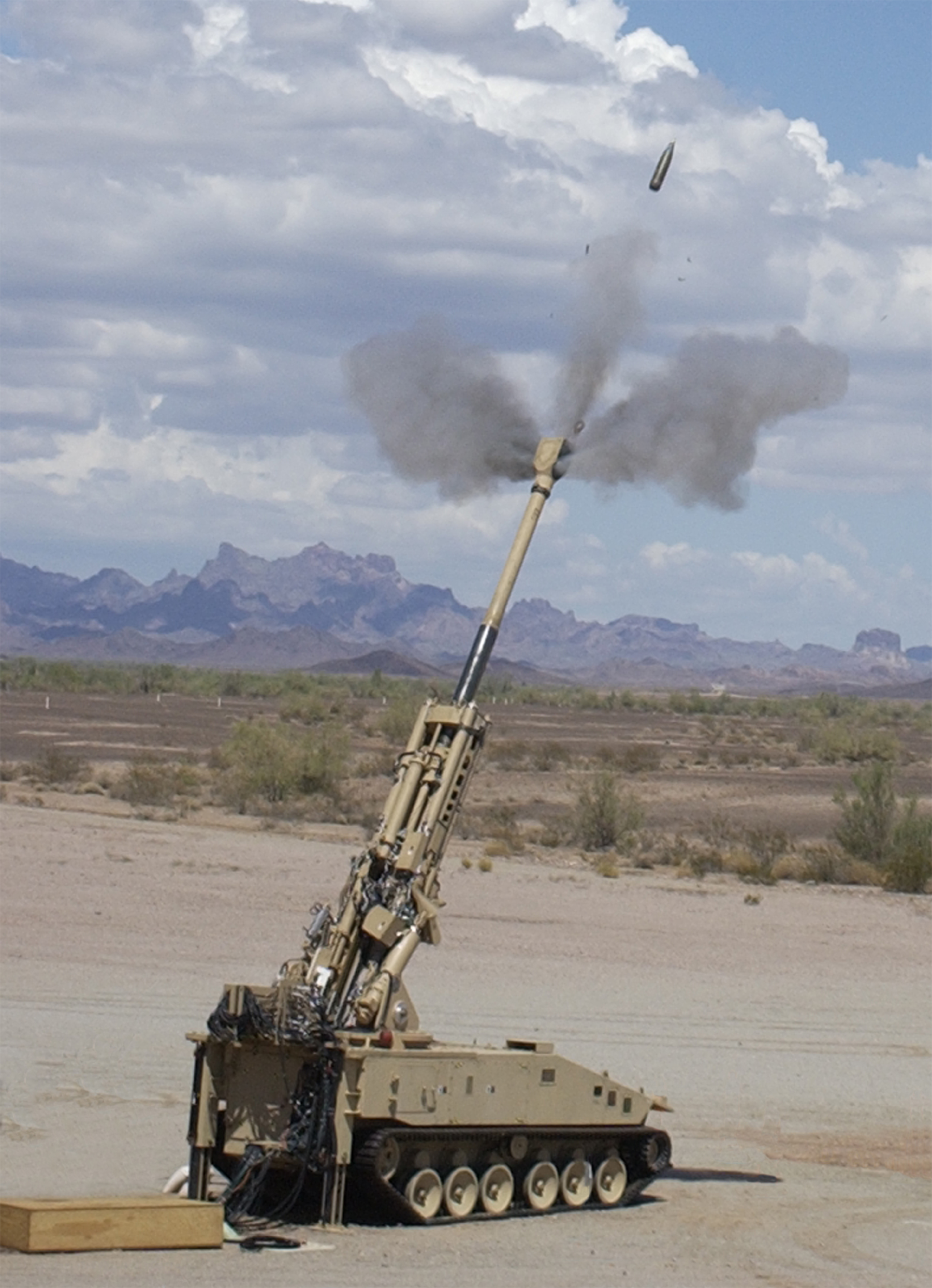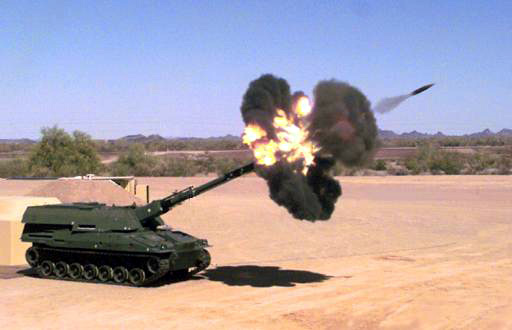|
M1299 Howitzer
The M1299 is an American prototype 155 mm turreted self-propelled howitzer developed by BAE Systems in 2019 under the Extended Range Cannon Artillery (ERCA) program. It is based on the M109A7 self-propelled howitzer, and was primarily designed for the purpose of improving the M109's effective range. History The Extended Range Cannon Artillery program was designed to produce a self-propelled howitzer system with an improved range and rate of fire compared to the existing M109A7 howitzer, in response to developments of Russian and Chinese artillery systems, which had become capable of outranging American systems. During tests conducted in 2018, the M777 howitzer was able to double its range through the use of higher energy propellant and rocket-assisted projectiles; hitting targets over away. Using the same principles, the Extended Range Cannon Artillery was developed. BAE Systems was given a $45 million contract in 2019 to incorporate the ERCA's cannon into a M109 chassis, ... [...More Info...] [...Related Items...] OR: [Wikipedia] [Google] [Baidu] |
Yuma Proving Ground
Yuma Proving Ground (YPG) is a United States Army series of environmentally specific test centers with its Yuma Test Center being one of the largest military installations in the world. It is subordinate to the U.S. Army Test and Evaluation Command. It's headquarters is co-located with its Yuma Test Center in southwestern La Paz County and western Yuma County in southwest Arizona, United States, approximately north of the city of Yuma, it encompasses 1,307.8 square miles (3,387.2 km²) in the northwestern Sonoran Desert. [...More Info...] [...Related Items...] OR: [Wikipedia] [Google] [Baidu] |
Benét Laboratories
Benét Laboratories, part of the US Army Combat Capabilities Development Command Armaments Center, is the US Army's primary design, development, engineering and production and field support facility for large caliber armament systems, including cannons, mortars, and recoilless rifles. The facility also works on tank gun mounts and turret components and munition handling systems. It is located at the Watervliet Arsenal in upstate New York. It is a part of the Weapons & Software Engineering Center (WSEC), US Army Combat Capabilities Development Command Armaments Center, which is located at Picatinny Arsenal, New Jersey. Laboratory simulations are performed studying gun firing phenomena, and using static and dynamic load testing (up to 5 million lb), as well as environmental testing. The laboratories are named after the first chief of Army ordnance, Brigadier General Stephen Vincent Benét Stephen Vincent Benét (; July 22, 1898 – March 13, 1943) was an American poet, short stor ... [...More Info...] [...Related Items...] OR: [Wikipedia] [Google] [Baidu] |
Self-propelled Howitzers Of The United States , a model for studying the motion of swarms
{{Disambiguation ...
Self-propelled may refer to * Human-powered transport, humans moving themselves (and their cargo) via their own muscle energy * Machines that power their own movement: ** Automobile (from ''auto-'' + ''mobile'', "self-moving") ** Locomotive (from ''loco-'' + ''motive'', "moving from its current place") ** Multiple units, self-propelled train carriages ** Self-propelled artillery *** Self-propelled gun *** Self-propelled anti-aircraft weapon *** Tank destroyer, a self-propelled anti-tank gun *** Mortar carrier, a self-propelled mortar ** Self-propelled modular transporter ** Leonardo's self-propelled cart ** Self-propelled barge T-36 * Self-propelled particles Self-propelled particles (SPP), also referred to as self-driven particles, are terms used by physicists to describe autonomous agents, which convert energy from the environment into directed or persistent motion. Natural systems which have insp ... [...More Info...] [...Related Items...] OR: [Wikipedia] [Google] [Baidu] |
155 mm Artillery
155 mm (6.1 in) is a common, NATO-standard, artillery caliber. It is defined in AOP-29 part 1 with reference to STANAG 4425. It is commonly used in field guns, howitzers, and gun-howitzers. Land warfare The caliber originated in France after its defeat in the Franco-Prussian War of 1870–1871, when an artillery committee met on 2 February 1874 to discuss new models for the French fortress and siege artillery, among which there was a piece in the caliber range (later on it became known as the De Bange 155 mm cannon). After several meetings, on 16 April 1874 the committee settled on the 15.5 cm caliber (in the subsequent program-letter of the committee, dating from 21 April 1874, the caliber was for the first time expressed as 155 mm). Since the early 21st century, most NATO armies have adopted 155 mm weapons as an all-purpose standard. They are seen as striking a good compromise between range and power, while only using a single caliber greatly simplifies the logi ... [...More Info...] [...Related Items...] OR: [Wikipedia] [Google] [Baidu] |
AHS Krab
The AHS Krab (Polish for crab) is a 155 mm NATO-compatible self-propelled tracked gun-howitzer designed in Poland by Huta Stalowa Wola (HSW), by combining the South Korean K9 Thunder chassis with a British BAE Systems AS-90M Braveheart turret with French Nexter Systems 52-calibre long gun and Polish WB Electronics' Topaz artillery fire control system. "AHS" is not a part of the name, but Polish abbreviation of ''armatohaubica samobieżna'' - gun-howitzer, self-propelled. The 2011 version used a Nexter Systems barrel and Polish UPG-NG chassis. The 2016 production batch utilized the Hanwha Defense K9 chassis with KMW+Nexter Defense Systems long gun, Rheinmetall barrel and STX Engine-MTU Friedrichshafen engine. full-rate production of 120 Krabs for the Polish Army has started with deliveries to be completed by 2024. , Huta Stalowa Wola started using barrels of their own manufacture in successive production batches. History The cannon was developed within the "Regina" researc ... [...More Info...] [...Related Items...] OR: [Wikipedia] [Google] [Baidu] |
Next Generation Combat Vehicle
The Next Generation Combat Vehicle (NGCV) is a United States Army program intended to procure a variety of armored vehicles to add new capabilities to Army units and replace existing platforms that are nearing the end of their service life. The program covers the following systems: * Optionally Manned Fighting Vehicle (OMFV), the replacement for the M2 Bradley IFV. * Armored Multi-Purpose Vehicle (AMPV), the replacement for the M113. * Mobile Protected Firepower (MPF), a light tank for Infantry Brigade Combat Teams (IBCTs). * Robotic Combat Vehicle (RCV), three unmanned ground vehicles in light, medium, and heavy configurations. * Decisive Lethality Platform (DLP), the replacement for the M1 Abrams main battle tank. Development The project began in 2017 after the previous Ground Combat Vehicle program was canceled. The deadline of the projects is expected to be 2035. Multiple groups competed for the bid. The Army gave the contract to a six member consortium - Lockheed Martin ... [...More Info...] [...Related Items...] OR: [Wikipedia] [Google] [Baidu] |
K-9 Thunder
The K9 Thunder is a South Korean 155 mm self-propelled howitzer designed and developed by the Agency for Defense Development and civil contractors including Dongmyeong Heavy Industries, Kia Heavy Industry, Poongsan Corporation, and Samsung Aerospace Industries for the Republic of Korea Armed Forces, and is now manufactured by Hanwha Defense. K9 howitzers operate in groups with the K10 automatic ammunition resupply vehicle variant. The entire K9 fleet operated by the ROK Armed Forces is now undergoing upgrades to K9A1, and a further upgrade variant K9A2 is being tested for production. As of 2022, the K9 series has had a 52% share of the global self-propelled howitzer market, including wheeled vehicles, since the year 2000. Development In the 1980s, the ROK Armed Forces came in need of a new artillery system to contest North Korean equipment. The armed forces operated M107 self-propelled guns and K55 self-propelled howitzers. However, they had shorter firing ranges compared ... [...More Info...] [...Related Items...] OR: [Wikipedia] [Google] [Baidu] |
Panzerhaubitze 2000
The Panzerhaubitze 2000 ("tank howitzer 2000"), () abbreviated PzH 2000, is a German 155 mm self-propelled howitzer developed by Krauss-Maffei Wegmann (KMW) and Rheinmetall in the 1980s and 1990s for the German Army. It is capable of a very high rate of fire; in burst mode it can fire three rounds in nine seconds, ten rounds in 56 seconds, and can—depending on barrel heating—fire between 10 and 13 rounds per minute continuously. The PzH 2000 has automatic support for up to five rounds of Multiple Round Simultaneous Impact (MRSI). Replenishment of shells is automated. Two operators can load 60 shells and propelling charges in less than 12 minutes. The PzH 2000 equips the armies of Germany, Italy, Ukraine, Netherlands, Greece, Lithuania, Hungary, Qatar and Croatia, mostly replacing older systems such as the M109 howitzer. In November 2019, a PzH 2000 L52 gun fired a shell a distance of 67 km. Development In 1986, Italy, the United Kingdom and Germany agreed to terminate ... [...More Info...] [...Related Items...] OR: [Wikipedia] [Google] [Baidu] |
Future Combat Systems Manned Ground Vehicles
The Manned Ground Vehicles (MGV) was a family of lighter and more transportable ground vehicles developed by BAE Systems and General Dynamics as part of the U.S. Army's Future Combat Systems (FCS) program. The MGV program was intended as a successor to the Stryker of the Interim Armored Vehicle program. The MGV program was set in motion in 1999 by Army Chief of Staff Eric Shinseki. The MGVs were based on a common tracked vehicle chassis. The lead vehicle, and the only to be produced as a prototype, was the Non-Line-of-Sight Cannon. Seven other vehicle variants were to follow. The MGV vehicles were conceived to be exceptionally lightweight (initially capped at 18 tons base weight) in order to meet the Army's intra-theatre airmobility requirements. The vehicles that the Army sought to replace with the MGVs ranged from 30 to 70 tons. In order to reduce weight, the Army substituted armor with passive and active protection systems. The FCS program was terminated in 2009 due to co ... [...More Info...] [...Related Items...] OR: [Wikipedia] [Google] [Baidu] |
XM1203 Non-Line-of-Sight Cannon
The XM1203 Non-Line-of-Sight Cannon (NLOS-C) was a 155 mm self-propelled howitzer. It was the lead vehicle for the U.S. Army's Future Combat Systems Manned Ground Vehicles program. The NLOS-C was a replacement for the M109 howitzer, but cancelled in December 2009. The NLOS-C used technology from the XM2001 Crusader, a U.S. Army self-propelled howitzer canceled in 2002. The NLOS-C provided networked, extended-range targeting, and precision attack of point and area targets in support of other combat units with a suite of munitions that included special purpose capabilities. The NLOS-C provided sustained fire for close support and destructive fire for tactical standoff engagement. The system's primary purpose was to provide responsive fire in support of the FCS Combined Arms battalions (CABs), and their subordinate units in concert with line-of-sight, beyond-line-of-sight, non-line-of-sight (NLOS), external and Joint capabilities. The system, as proposed, looked to add capabilit ... [...More Info...] [...Related Items...] OR: [Wikipedia] [Google] [Baidu] |
XM2001 Crusader
The XM2001 Crusader was to be the United States Army's next-generation self-propelled howitzer (SPH), designed to improve the survivability, lethality, mobility, and effectiveness of the artillery as well as the overall force. It was initially scheduled for fielding by 2008. United Defense was the prime contractor; General Dynamics the major subcontractor. In early May 2002, Secretary of Defense Donald Rumsfeld canceled the US$11 billion program because he considered it neither mobile nor precise enough. The prototype SPH vehicle is on display at the cannon park at Fort Sill. Inception The Crusader was conceived as the Advanced Field Artillery System (AFAS), part of a family of vehicles built around a common chassis in the Armored Systems Modernization program. In October 1992, the Army canceled Armored Systems Modernization due to changing budgetary priorities caused by the collapse of the Soviet Union. In 1994 AFAS was renamed "Crusader." In 1996, the Crusader's experimental ... [...More Info...] [...Related Items...] OR: [Wikipedia] [Google] [Baidu] |







